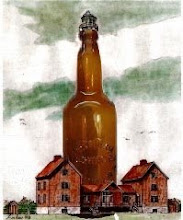The Christmas Party was a huge success!
Thanks to New Holland for allowing us to hold it at their facility and for the wonderful firkin of Cabin Fever!
Good food, always good beer and great friends!
Merry Christmas from Brewers On The Lake!
Wednesday, December 18, 2013
Monday, December 16, 2013
Thursday, December 5, 2013
Take Advantage Of Winter And Brew A Lager Beer!
 There is a bit of extra work, but there are some painless ways to make consistently good lager beer. This is possible regardless of your experience level or whether you brew with extract or all-grain. Cold storage space always seems to be at a premium which is why I make my lagers in November thru January and take advantage of Michigan Winter's cold storage in my garage.
There is a bit of extra work, but there are some painless ways to make consistently good lager beer. This is possible regardless of your experience level or whether you brew with extract or all-grain. Cold storage space always seems to be at a premium which is why I make my lagers in November thru January and take advantage of Michigan Winter's cold storage in my garage.One of the main tricks to successfully making a lager is to use a good volume of active, healthy yeast. You should always make a starter for lagers, leaving it to build up at room temperature. Remember you are making yeast, not beer, so leave the starter to do it's important work at room temperature. Also, I do not bother to decant the liquid in the starter unless it's a large amount of liquid. If I have adequate yeast with just a few ounces of wort, I pitch the whole thing. If you decide to save your lager yeast at the end of fermantation and use it again, it's important to store it cold to prevent it causing off-flavors. I like to make a light lager (ie.pilsner or helles) and then make another lager and pitch all of that healthy yeast that was built up from the previous beer.
After you have boiled the wort it is important to cool it down to 50 degrees or less, this will take some extra time, but it is proper to make a clean lager. Pitch the yeast when the wort has been cooled to 50 degrees or lower and oxygenate your wort properly for best results. Do not pitch warm (65 deg) and then cool to fermentation temps. If the lager yeast has contact with warmer wort, even for 24 hours, it can produce off-flavors and esters that will detract from the flavor of your beer. Be sure to keep the primary at a consistent, proper temperature throughout the primary fermentation. Some lager yeast fermentation temps vary, but if you maintain 50 degrees for 10 days you should end up with a good lager beer.
One should also perform a diacetyl rest near the end of primary fermentation (8-10 days). Meaning, move the beer from it's ferment "chamber"(~50°) and allow it to warm (~60°) gradually for 3 days. This allows the yeast to clean up certain flavors (buttery, for one) that are produced during the cool primary.
Next is the lagering phase of placing the beer at 35-38 degree temps for 8 weeks (the amount of lager time can vary). If you don't have refridgerator room then just transfer into a keg and set it in the garage for winter lagering. After lagering, carbonate and enjoy!
Some other items to note about lagers is a primary will be a little less active than an ale primary. There will probably be less kraeusen on top of the beer and the whole process will seem a bit more subdued which is normal. Also, some lager yeasts will produce a sulphur-like aroma towards the end of primary which should not carry over to your glass of beer. The aroma should begin to fade during the secondary phase and disappear altogether by the time the beer is served.
Lager styles
Wednesday, December 4, 2013
Subscribe to:
Comments (Atom)




